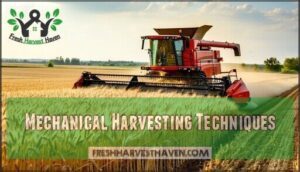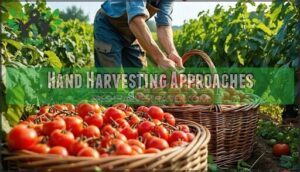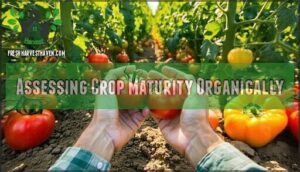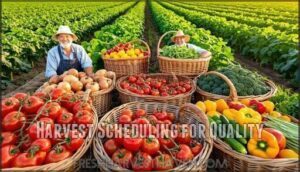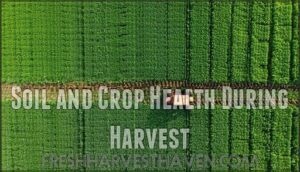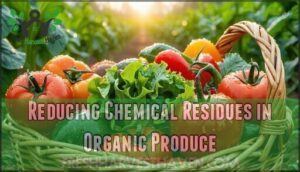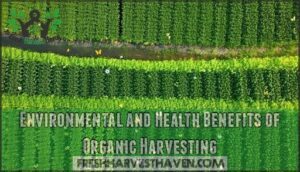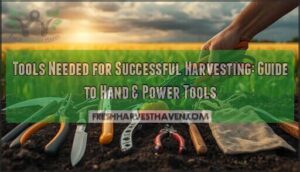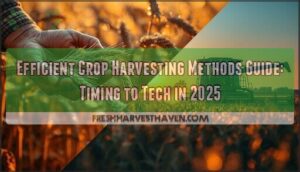This site is supported by our readers. We may earn a commission, at no cost to you, if you purchase through links.
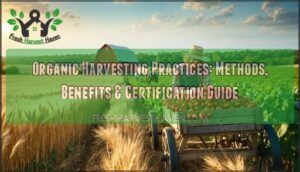
You’ll use mechanical harvesters or hand-picking techniques, ensuring equipment stays sanitized to meet certification standards.
These methods reduce energy use by 30-50% compared to conventional farming while protecting biodiversity.
Timing becomes vital—you’ll rely on visual cues and natural ripening instead of synthetic agents.
Post-harvest handling requires organic-certified storage with proper temperature control and contamination prevention.
The result? Nutrient-rich crops with minimal environmental impact.
But there’s more to mastering the timing, equipment choices, and certification requirements that can make or break your organic operation.
Table Of Contents
- Key Takeaways
- What Are Organic Harvesting Practices?
- Approved Methods for Organic Harvesting
- Timing and Preparation for Organic Harvests
- Post-Harvest Handling and Storage
- Soil and Crop Health During Harvest
- Reducing Chemical Residues in Organic Produce
- Environmental and Health Benefits of Organic Harvesting
- Frequently Asked Questions (FAQs)
- What connects all organic farming practices?
- What makes a good organic produce?
- Why is organic farming important?
- Are organic producers required to implement crop rotation?
- How do organic farmers choose the right varieties?
- How do organic farmers reduce insect and disease levels?
- What are organic farming practices?
- What are good harvesting practices?
- What are the 4 principles of organic farming?
- What is an organic practice?
- Conclusion
Key Takeaways
- You’ll need to follow strict certification standards that eliminate synthetic chemicals while using mechanical harvesters or hand-picking techniques with proper equipment sanitation
- You’ll rely on visual cues and natural ripening indicators rather than synthetic agents to determine perfect harvest timing, typically within narrow 3-7 day windows
- You’ll require organic-certified storage with temperature control, contamination prevention, and dedicated handling protocols to maintain organic integrity from harvest to market
- You’ll reduce energy use by 30-50% compared to conventional methods while protecting biodiversity and producing crops with up to 20% higher antioxidant levels
What Are Organic Harvesting Practices?
You’ll find that organic harvesting practices follow strict guidelines that prioritize natural methods and prohibit synthetic chemicals throughout the collection process.
These certified approaches use both mechanical and hand-harvesting techniques while maintaining soil health and preventing contamination from conventional farming residues, which is crucial for soil health.
Definition and Key Principles
Organic harvesting practices represent the final step in organic agriculture, where you’ll collect crops using natural processes that maintain organic integrity throughout the entire production cycle.
The culmination of sustainable farming – where nature’s bounty meets mindful cultivation practices
These sustainable methods prohibit synthetic chemicals while emphasizing biodiversity focus and adherence to strict organic standards.
Your organic certification depends on following these organic methods consistently, ensuring organic integrity and compliance with strict organic standards.
Differences From Conventional Harvesting
Unlike conventional farming, organic harvesting practices eliminate synthetic pesticides and fertilizers throughout the entire process.
You’ll notice significant differences in energy efficiency, with organic methods using 30-50% less energy per unit of crop.
While conventional farming prioritizes maximum crop yield comparison, organic approaches focus on environmental sustainability and soil health.
Farm labor practices emphasize careful handling to prevent contamination, and water usage differences reflect conservation priorities over volume production.
Role of Certification Standards
Getting certified organic involves rigorous standards that govern your entire harvesting operation.
You’ll navigate the USDA Certified Organic certification process, meeting strict accreditation standards for quality assurance.
Regulatory compliance covers everything from equipment sanitation to storage protocols.
The organic certification costs range from hundreds to thousands annually, but those coveted organic labels grant access to premium markets worth the investment.
Approved Methods for Organic Harvesting
When you’re ready to harvest your organic crops, you’ll need to follow specific approved methods that maintain your certification status.
These techniques focus on mechanical harvesting, hand-picking approaches, and proper equipment sanitation to guarantee your produce meets organic standards, ensuring you use proper equipment.
Mechanical Harvesting Techniques
Modern farm equipment revolutionizes organic harvesting practices through sophisticated machine harvesting systems.
Combine harvesters excel at precision farming for grains, while trunk shakers achieve 58-63% success rates in orchards.
Harvest automation reduces labor costs by 80-90% in crops like cherries, and these harvesting tools maintain organic standards while boosting crop yields through advanced harvesting methods and crop monitoring technologies.
Effective use of sustainable farming practices is essential for long-term success in organic farming.
Hand Harvesting Approaches
Hand harvesting approaches prioritize careful crop selection and quality control through skilled labor practices.
You’ll use specialized harvesting tools like sickles, knives, and scissors for maximum yield management. This method requires strategic farm logistics and timing within your crop rotation schedule.
Key advantages include:
- Premium quality – selective picking guarantees only ripe produce reaches market
- Minimal damage – gentle handling preserves delicate fruits and vegetables
- Enhanced biodiversity – reduced machinery protects soil structure and beneficial organisms
These organic harvesting practices demand more labor but deliver superior harvesting methods results.
Effective postharvest handling involves understanding proper storage methods to maintain quality.
Equipment Cleaning and Sanitation
You’ll need proper cleaning protocols to keep your harvesting tools safe for organic produce.
Clean equipment with approved sanitizer types between different crops to prevent disease spread.
Water quality matters – use potable water for washing tools and maintain storage hygiene in designated areas.
Regular equipment maintenance includes scrubbing bins, sanitizing surfaces, and checking for contamination sources.
These garden hygiene practices protect your harvest and support effective disease prevention throughout your garden care routine.
Effective equipment sanitation requires using a reliable sanitizer for equipment to guarantee cleanliness and safety.
Timing and Preparation for Organic Harvests
Timing your organic harvest correctly means knowing when crops reach peak maturity without relying on synthetic ripening agents or chemical indicators.
You’ll need to balance ideal ripeness with weather conditions and natural storage life to maximize both quality and yield.
Assessing Crop Maturity Organically
Organic Timing depends on visual and physical indicators rather than synthetic ripening agents.
Crop Monitoring through direct observation helps determine Harvest Readiness naturally. Plant maturity assessment uses multiple sensory cues for ideal Crop Inspection.
Five key Maturity Tests for organic harvesting practices:
- Surface color changes – Green tomatoes turning red indicates natural ripening
- Ground spot development – Creamy yellow patches on melons signal readiness
- Texture assessment – Hand-testing firmness in stone fruits and leafy greens
- Shape evaluation – Full, blocky bell peppers show complete development
- Growing degree day calculations – Heat unit accumulation predicts timing for crop rotation scheduling
Weather and Environmental Considerations
Weather conditions directly influence your harvesting decisions and crop quality outcomes.
Rainfall impact can cause soil compaction and increase disease risks, while temperature effects determine ideal harvest windows for peak nutritional content.
Climate change intensifies seasonal variations, creating unpredictable extreme weather patterns that challenge traditional harvesting practices.
You’ll need flexible scheduling to adapt environmental conditions while maintaining sustainable yields and protecting environmental health throughout your organic operations.
Harvest Scheduling for Quality
Timing your harvest correctly transforms good crops into exceptional ones.
You’ll need to monitor maturity indicators like color, firmness, and sugar content to determine perfect timing.
Most crops have narrow harvest windows—typically 3-7 days—where quality metrics peak.
Smart farmers use predictive modeling alongside traditional methods to nail perfect harvest timing.
This precision in organic farming guarantees your produce quality meets market standards while maximizing nutritional value.
It is crucial for farmers to understand that perfect timing is key to achieving high-quality produce.
Post-Harvest Handling and Storage
After you’ve carefully harvested your organic crops, proper post-harvest handling becomes critical for maintaining their certified organic status and quality.
You’ll need to follow strict storage requirements and contamination prevention protocols to preserve both the organic integrity and nutritional value of your produce.
Organic-Certified Storage Requirements
Storage facilities must meet strict organic certification standards to maintain product integrity.
You’ll need proper documentation, segregation systems, and approved cleaning protocols to prevent contamination and guarantee compliance with organic regulations.
Essential organic storage requirements include:
- Temperature Control and Traceability Systems – Maintain calibrated climate controls with daily monitoring logs and batch tracking from harvest to distribution
- Pest Prevention and Organic Handling – Use approved biological controls, pheromone traps, and physical barriers instead of chemical fumigants
- Packaging Materials and Organic Compliance – Store products in certified organic-approved containers with clear labeling and physical separation from conventional goods
Sorting, Washing, and Peeling Methods
Precision in post-harvest operations determines your produce quality and market success.
You’ll start with organic sorting, separating damaged items from premium fresh produce based on ripeness and visual standards.
Washing techniques must follow strict sanitation standards using approved cleaners that won’t compromise organic certification.
For peeling alternatives, consider minimal processing to preserve nutrients while meeting food safety requirements.
To streamline this process, consider investing in efficient sorting equipment.
These handling and storage practices reduce waste through careful evaluation, ensuring your harvesting practices maintain the integrity that organic consumers expect from farm to table.
Preventing Cross-Contamination
Cross-contamination threatens your organic certification faster than you’d think.
Establish strict buffer zones between organic and conventional areas, maintaining separate equipment sanitation protocols for each system.
Train workers in proper hygiene practices, including handwashing stations and clean clothing changes.
Implement dedicated storage protocols with clearly labeled containers, preventing organic contamination during transport.
Proper storage helps maintain peak nutrition and flavor for harvested goods, as seen in the guide on peak nutrition and flavor.
Your organic packing and postharvest handling success depends on fastidious contamination prevention throughout every storage step.
Soil and Crop Health During Harvest
You’ll protect your soil’s long-term health and maintain valuable ecosystems during organic harvest operations. Proper techniques prevent compaction damage while preserving the biodiversity that supports sustainable crop production.
Protecting Soil Structure and Fertility
Once you’ve properly stored your organic harvest, focus on maintaining your soil’s foundation.
Organic harvesting protects soil health through careful timing and equipment selection. Use lighter machinery when possible to reduce compaction.
Apply organic composting immediately after harvest to boost soil organic matter levels. Plant cover crops quickly to maintain nutrient cycling and prevent erosion.
These practices preserve soil biodiversity while supporting long-term fertility for future growing seasons.
Minimizing Erosion and Compaction
Heavy machinery crushes soil structure and limits water infiltration during harvest.
You’ll protect your fields by using reduced tillage methods and planning strategic pathways for equipment.
Cover cropping between harvest seasons prevents soil erosion while adding organic matter.
These practices maintain soil health and support long-term compaction prevention in your organic management system.
To further improve soil fertility, consider using composted organic materials to enhance soil fertility and promote organic management.
Maintaining Biodiversity and Habitat
You’ll protect biodiversity during harvesting by creating Wildlife Corridors between fields and preserving Native Species habitats.
Maintain buffer zones around water sources and hedgerows for Pollinator Protection.
Your organic farming practices support Ecosystem Services by avoiding chemical disruptions.
Schedule harvesting to minimize wildlife disturbance during breeding seasons, and these Habitat Restoration efforts strengthen ecological balance while supporting beneficial insects and natural pest control systems.
Reducing Chemical Residues in Organic Produce
When you’re harvesting organic produce, you’re working with crops grown without synthetic pesticides, herbicides, or fertilizers, which means markedly lower chemical residue levels compared to conventional farming.
Proper organic harvesting techniques focus on maintaining this clean status through careful handling, equipment sanitation, and avoiding cross-contamination with non-organic materials during the collection process, ensuring the produce retains its clean status and is handled with care to prevent cross-contamination.
Prohibition of Synthetic Chemicals
Organic harvesting practices eliminate synthetic chemicals completely, creating a safety net for both crops and consumers.
You’ll find this prohibition extends beyond obvious pesticides to include synthetic fertilizers, growth regulators, and processing aids.
Here’s what gets banned under organic standards:
- Synthetic pesticides – No chemical sprays, fungicides, or herbicides allowed
- Artificial fertilizers – Petroleum-based nitrogen and synthetic phosphorus are off-limits
- Growth hormones – No synthetic plant regulators or ripening agents permitted
- Processing chemicals – Synthetic preservatives and additives can’t touch your crops
This chemical-free farming approach prevents soil contamination and water pollution while supporting natural inputs and residue avoidance in your harvest.
Natural Pest and Disease Controls
You’ll rely on biological controls instead of synthetic chemicals during harvest season.
Beneficial insects like predatory beetles tackle pests naturally, while microbial solutions containing Trichoderma suppress soil pathogens effectively.
Natural pesticides from neem and essential oils provide targeted control without residues.
Crop rotation disrupts pest cycles, and physical barriers protect vulnerable crops while maintaining disease resistance through healthy soil ecosystems.
Safe Handling to Limit Residue Risks
Careful handling protocols during harvest protect your organic integrity.
You’ll minimize residue risks through proper equipment sanitation between fields and thorough worker training on contamination prevention.
Clean harvesting tools before touching fresh produce, and monitor plant maturity to avoid stressed crops that accumulate unwanted compounds.
These harvesting practices guarantee your organic certification remains intact.
To maximize nutritional value, consider harvesting during cool mornings.
Environmental and Health Benefits of Organic Harvesting
When you choose organic harvesting practices, you’re protecting biodiversity while ensuring your crops contain higher nutritional value than conventionally grown produce.
These methods reduce environmental impact through lower energy use and eliminate exposure to synthetic chemicals that can harm both ecosystems and human health.
Biodiversity and Ecosystem Protection
Twenty-five percent more species thrive when you practice organic farming, creating natural sanctuaries that support wildlife.
Organic farming transforms barren fields into thriving wildlife sanctuaries where nature flourishes
Your fields become living ecosystems where soil microbes flourish and carbon sequestration increases by 200-300 kg per hectare annually. Water quality improves as you eliminate synthetic chemicals. Organic produce also has more vitamin C than conventional alternatives.
Here’s how biodiversity flourishes:
- Pollinator Protection – Your chemical-free fields provide safe havens for bees, butterflies, and beneficial insects
- Habitat Preservation – Crop rotations and cover crops create diverse environments supporting birds and wildlife
- Ecological Balance – Natural predators control pests while maintaining resilient ecosystems for sustainable yields
Healthier, Nutrient-Rich Crops
When you harvest organically grown produce, you’re getting crops packed with superior nutritional value.
Organic farming practices create healthier soil conditions that boost nutrient density in your food.
These enhanced growing methods increase antioxidant levels by up to 20% compared to conventional crops.
Your organic vegetables contain higher vitamin content and improved mineral absorption rates.
The natural plant health from organic methods translates directly into better-flavored, more nutritious harvests on your plate.
Lower Environmental Impact
Why settle for farming methods that drain our planet?
Organic harvesting practices slash greenhouse gas emissions by requiring 30% less energy per acre.
These eco-friendly practices promote water conservation through reduced chemical runoff, enhance energy efficiency with natural processes, and support soil preservation.
Smart harvesting tools and harvest preservation methods minimize waste reduction while protecting ecosystems for future generations.
Frequently Asked Questions (FAQs)
What connects all organic farming practices?
Like threads in nature’s tapestry, you’ll find natural processes weave through every organic farming practice.
Whether you’re building soil health, managing pests, or harvesting crops, everything connects through avoiding synthetic chemicals and embracing biodiversity.
What makes a good organic produce?
Good organic produce starts with healthy soil that’s rich in nutrients and free from synthetic chemicals.
You’ll recognize quality organic items by their vibrant colors, firm texture, and natural appearance without artificial enhancements or preservatives, which is a key factor in identifying organic produce.
Why is organic farming important?
You’re choosing healthier food while protecting the environment.
Organic farming eliminates toxic chemicals, builds soil health, increases biodiversity by 30%, reduces greenhouse gas emissions, and supports sustainable agriculture that won’t deplete natural resources.
Are organic producers required to implement crop rotation?
Rotating crops like spinning plates keeps your soil balanced and healthy.
Yes, you’re required to rotate crops in organic farming – it’s a cornerstone practice that prevents soil depletion and naturally controls pests.
How do organic farmers choose the right varieties?
You’ll select varieties based on your climate zone, soil conditions, and market demand.
Choose disease-resistant cultivars that thrive without synthetic inputs, considering maturity dates for continuous harvests throughout your growing season.
How do organic farmers reduce insect and disease levels?
Think of your farm as a fortress – you’ll build multiple defense layers using biological controls like beneficial insects and Bt, physical methods like traps and hand removal.
Plus cultural practices including crop rotation and resistant varieties to naturally suppress pests and diseases, utilizing biological controls to enhance overall farm health.
What are organic farming practices?
You’ll use crop rotation, cover crops, and composting to build healthy soil naturally. Natural pest control methods replace synthetic chemicals, while hand-harvesting and mechanical techniques guarantee quality produce.
What are good harvesting practices?
Timing matters more than you’d think—harvest at peak ripeness when morning dew’s dried but before midday heat.
You’ll want clean hands, sharp tools, and gentle handling to preserve quality and extend shelf life, with gentle handling being crucial.
What are the 4 principles of organic farming?
Organic farming rests on four core principles: health, ecology, fairness, and care.
You’ll find these principles guide sustainable practices that protect soil, support biodiversity, guarantee fair treatment throughout the supply chain, and promote responsible stewardship.
What is an organic practice?
Adopting chemical-free farming methods means you’ll embrace natural processes like composting, crop rotation, and biological pest control. You’re building healthier soil while protecting water sources and biodiversity.
Conclusion
Congratulations, you’ve mastered the art of making dirt taste better—though your neighbors still think you’re obsessive about avoiding chemicals.
Implementing organic harvesting practices requires dedication to certification standards, proper equipment sanitation, and natural timing methods.
You’ll protect soil health while producing nutrient-rich crops that benefit both ecosystems and human health.
These sustainable techniques reduce environmental impact by up to 50% compared to conventional methods.
Success depends on consistent application of approved harvesting methods, post-harvest handling protocols, and maintaining strict contamination prevention measures throughout your operation.

